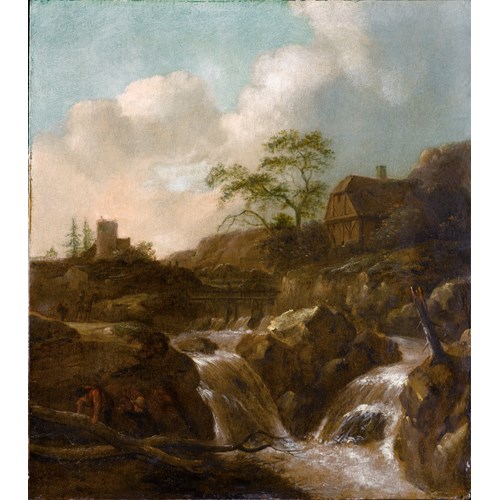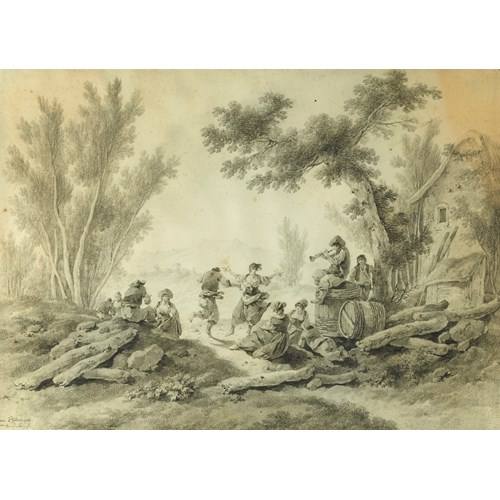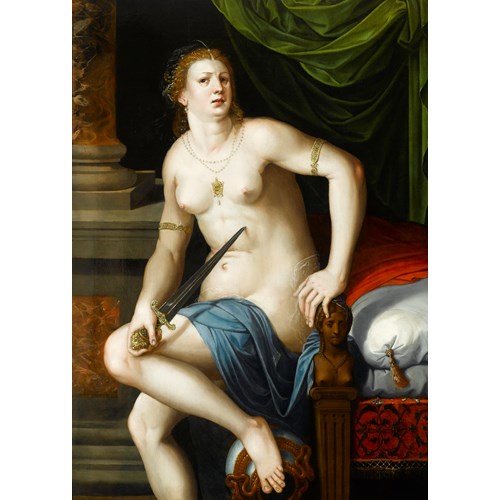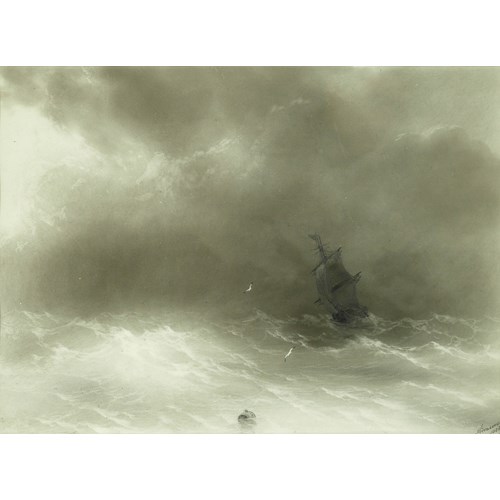Marketplace
Russian Village in the Winter
Aleksey Ilyich Kravchenko
Russian Village in the Winter
Period 20th century
Origin Russia
Medium Oil on board
Dimension 49 x 64 cm (19¹/₄ x 25¹/₄ inches)
The sketch-like execution of Russian Village in the Winter defines the character of the painting. The free use of broken brushstrokes and cool colours evoke the cold and sparse feeling of this winter day in Russia. The technique is particularly effective in the terrain of the foreground which imitates the slushy nature of the path that would occur as people journey along the melting snow. Aleksey Ilyich Kravchenko has applied paint thinly in many areas, leaving parts of the panel untouched. This creates a translucent effect with areas of the panel showing through, which works well both in rendering the barren land and the cool sky typical of a winter’s day. The solitary figure of the horse set in this otherwise figureless and bleak landscape creates this villages sense of remoteness.
Kravchenko painted many similar scenes of rural Russia, in which his remarkable ability to effectively convey the atmospheric conditions of the landscape shines through. Spring Landscape, (Private Collection), is a comparable example which shows a similar settlement, albeit from a more distant viewpoint. In both works Kravchenko’s palette is dominated by browns, whites and blues, and by using these colours through expressive brushstrokes he evokes the particular climate in each work beautifully. In the present work one can sense the bitter chill, the dominant greys and browns suggestive of the harshness of the winter. Although Spring Landscape is also snow-covered, it is a brighter work and therefore conveys a pleasanter crispness than the barren starkness of Russian Village in the Winter. There is also a stillness and tranquillity about both works, accentuated by the motif of a solitary horse and sleigh, which Kravchenko uses in each scene.
The art of Kravchenko is firmly rooted in the 1920s and 30s, successfully uniting Russian and European traditions. In his painting, Kravchenko rejected a naturalist depiction of the subject in front of him and instead aimed to instil it with his personal feeling and internal observations. In this respect, Kravchenko’s style can be described as neo-romantic grotesque, impressive in its dynamics, intricate contrasts and spirited pictorialism.
In 1904, Kravchenko was admitted to the Moscow School of Painting, Sculpture and Architecture where he studied under Sergey Vasilievich Ivanov (1864-1910), Abram Efemovich Arkhipov (1862-1930), Konstantin Alekseevich Korovin (1861-1939) and Valentin Alexandrovich Serov (1865-1911), graduating with distinction in 1910. He then travelled to Italy and Greece, researching large-scale painting and frescoes. His Italian and Russian landscapes received much public recognition and were exhibited by the Union of Russian Artists, the World of Art movement and the Moscow Artists’ Fellowship.
Kravchenko was not, however, limited to painting alone. He also worked in Saratov as a stage designer, poster artist and designer of monumental propaganda stagings. When he moved to Moscow he became a member of the Four Arts Society of Artists. Active from 1924-1932, the society aimed to include representatives of all ‘Four Arts’, painting, sculpture, graphics and architecture. Kravchenko concentrated on both book illustration and graphic art and due to his Neo-romantic style, established a successful career in illustrating the work of prominent Romantic writers such as Nikolay Gogol (1809-1952), Ernst Hoffmann (1776-1822), Victor Hugo (1802-1885) and Stefan Zweig (1881-1942). Kravchenko created his most accomplished illustrations for Gogol’s Portret (‘Portrait’, 1929 edition) using wood engravings.
Despite his multifaceted activities, Kravchenko continued to paint throughout his career and became a professor at the Surikov Art Institute, Moscow. He exhibited internationally in the 1920s with renowned artists such as Marc Chagall (1887-1985), Kazimir Malevich (1879-1935), Léon Bakst (1866-1924), Wassily Kandinsky (1866-1944) and others. His work is represented in the Tret’yakov Gallery, Moscow, amongst other collections.
We are grateful to Vladimir Petrov for confirming the attribution of this work.
Kravchenko painted many similar scenes of rural Russia, in which his remarkable ability to effectively convey the atmospheric conditions of the landscape shines through. Spring Landscape, (Private Collection), is a comparable example which shows a similar settlement, albeit from a more distant viewpoint. In both works Kravchenko’s palette is dominated by browns, whites and blues, and by using these colours through expressive brushstrokes he evokes the particular climate in each work beautifully. In the present work one can sense the bitter chill, the dominant greys and browns suggestive of the harshness of the winter. Although Spring Landscape is also snow-covered, it is a brighter work and therefore conveys a pleasanter crispness than the barren starkness of Russian Village in the Winter. There is also a stillness and tranquillity about both works, accentuated by the motif of a solitary horse and sleigh, which Kravchenko uses in each scene.
The art of Kravchenko is firmly rooted in the 1920s and 30s, successfully uniting Russian and European traditions. In his painting, Kravchenko rejected a naturalist depiction of the subject in front of him and instead aimed to instil it with his personal feeling and internal observations. In this respect, Kravchenko’s style can be described as neo-romantic grotesque, impressive in its dynamics, intricate contrasts and spirited pictorialism.
In 1904, Kravchenko was admitted to the Moscow School of Painting, Sculpture and Architecture where he studied under Sergey Vasilievich Ivanov (1864-1910), Abram Efemovich Arkhipov (1862-1930), Konstantin Alekseevich Korovin (1861-1939) and Valentin Alexandrovich Serov (1865-1911), graduating with distinction in 1910. He then travelled to Italy and Greece, researching large-scale painting and frescoes. His Italian and Russian landscapes received much public recognition and were exhibited by the Union of Russian Artists, the World of Art movement and the Moscow Artists’ Fellowship.
Kravchenko was not, however, limited to painting alone. He also worked in Saratov as a stage designer, poster artist and designer of monumental propaganda stagings. When he moved to Moscow he became a member of the Four Arts Society of Artists. Active from 1924-1932, the society aimed to include representatives of all ‘Four Arts’, painting, sculpture, graphics and architecture. Kravchenko concentrated on both book illustration and graphic art and due to his Neo-romantic style, established a successful career in illustrating the work of prominent Romantic writers such as Nikolay Gogol (1809-1952), Ernst Hoffmann (1776-1822), Victor Hugo (1802-1885) and Stefan Zweig (1881-1942). Kravchenko created his most accomplished illustrations for Gogol’s Portret (‘Portrait’, 1929 edition) using wood engravings.
Despite his multifaceted activities, Kravchenko continued to paint throughout his career and became a professor at the Surikov Art Institute, Moscow. He exhibited internationally in the 1920s with renowned artists such as Marc Chagall (1887-1985), Kazimir Malevich (1879-1935), Léon Bakst (1866-1924), Wassily Kandinsky (1866-1944) and others. His work is represented in the Tret’yakov Gallery, Moscow, amongst other collections.
We are grateful to Vladimir Petrov for confirming the attribution of this work.
Period: 20th century
Origin: Russia
Medium: Oil on board
Signature: Signed in Cyrillic (lower right)
Dimension: 49 x 64 cm (19¹/₄ x 25¹/₄ inches)
More artworks from the Gallery









